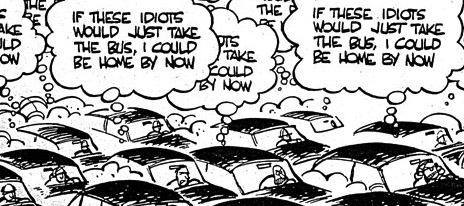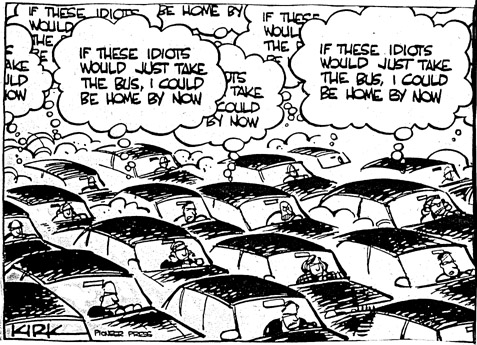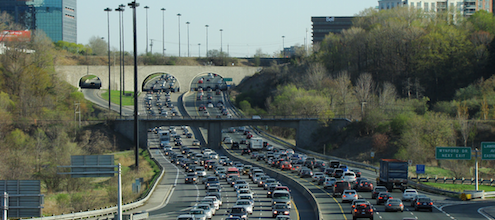
4 Things You Should Know About HOT Lanes
More choice, less traffic. Let’s have a real conversation about how HOT lanes work and who benefits.
Last week, Kathleen Wynne reiterated that HOT lanes (High Occupancy Toll lanes) are on the province’s agenda. She didn’t say where and she didn’t say when, but she did say that planning is in the works and that the lessons learned from Toronto’s temporary HOV lanes are instructive.
That the PanAm HOV lane experiment (which required carpools of three or more people) unlocked some human ingenuity in terms of how we get from A to B is a good thing. After all, congestion is the result of too many people trying to do the same thing (drive) at the same time (rush hour) in the very same place (insert your favourite congested highway here). Paul Berton, editor of the Hamilton Spectator, put it really well earlier this week: Around the world, transit officials, planners, urbanists, politicians and, above all, economists are realizing we cannot afford — financially, environmentally, socially, politically — to continue building cities and moving about in them as we always have. Ingenious solutions are indeed needed.
Funny but True: If only we all had more and better choices. Could HOT lanes help?

Ultimately, solving our traffic problems is about two related issues. One, people need more—and better—choices about how to get around. This definitely means broader access to public transit. Second—and here’s the one we often ignore—people need good reasons to make different choices, not just about how to get from here to there, but also where and when.
HOT lanes—a hybrid of tolled roads and HOV lanes—help address both of those issues. Here’s how:
1. They give more people more choices
For all sorts of reasons, carpooling is a great thing and the upswing in carpool activities (and technology supporting those activities) can only be seen as a positive outcome of Toronto’s HOV lane experiment. But not everyone can carpool all of the time. There’s the early meeting, the soccer practice after work, the necessary lunch-hour dental appointment—whatever. Our routines vary and so do our transportation needs. The biggest complaint expressed by many about the PanAm HOV lanes was their underuse, perhaps reflecting this fact.
HOT lanes give people an alternative way to move out of regular traffic. You can still access the lanes by carpooling or you can pay a fee. Carpoolers still have an advantage and an incentive (free access to faster lanes). But if you can’t carpool and you have to drive and you need to get where you’re going faster, the HOT lane is a great, reliable choice.
2. They make all lanes of traffic move faster
HOT lanes offer an advantage even to people who don’t use them because getting cars out of the way of regular traffic means that everyone on the road goes faster.
That’s what happened in Minneapolis. The city started converting its HOV lanes into HOT lanes in 2005. In addition to maintaining a “fast” lane with an average speed of about 80KM per hour, speeds increased on the normal lanes by 6 per cent. Other places with HOT lanes have seen similar results.
In Florida, highway I-95 connecting Miami and Fort Lauderdale was so backed up that people in both the carpool lanes and the regular lanes crawled at a snail’s pace. The conversion to HOT lanes cut delay times for everyone significantly. Here’s a fact: the people in the normal lanes saw their delays cut by 50% as a result of other people choosing the HOT lane.
3. They can improve and even create new public transit options
One of the happy discoveries of Toronto’s HOV experiment was the increased speed and reliability of GO busses. With access to the express lanes, bus commuters ended up saving as much as 20 minutes on their rides to and from work. HOT lanes, especially those that prioritize public transit, offer the same benefit.
When HOT lanes are developed as part of an even broader strategy, they can lead to better and even more public transit options. A number of cities have used HOT lanes as an opportunity to ramp up and increase rapid bus service. In San Diego, for example, the HOT lane project was designed, in part, to fund new express bus service along the same route. Similarly, Miami added three new express bus routes as part of its HOT lane project.
4. They give everyone a reliable option
From San Diego, to Minnesota, to Washington State – people who live with HOT lanes overwhelmingly like them. And that support comes as much, if not more, from lower and middle-income people as it does from the rich. The thing that people seem to like best about HOT lanes is that they are there when and if they need them. For most people, that’s not all the time – but rather when the situation demands it.
Studies show that people of all walks of life take advantage of HOT lanes, though wealthier people might do so with more regularity. But everybody—no matter income level or job—tends to use them for the same reasons: to avoid being late for work, to pick up the kids on time from daycare, to make that appointment.
As a working mom, I can easily bring to mind a few gross moments when I would have happily paid a few bucks not to be late (again). And the research suggests that I’m probably not alone. One poll found that 70% of drivers in the GTA would be willing pay $2 to use a fast lane.
One of the worst aspects of being stuck in traffic is that feeling of no control. The value of HOT lanes is knowing that if I need to get there, and I need to get there now, I can.
Sure, HOT lanes aren’t the silver bullet solution for all of our traffic woes. But they can make an important difference, especially when they are part of a bigger plan that includes better transit. When it comes to getting around our increasingly gridlocked cities, we need and deserve all the options we can get. So let’s put them all on the table and not dismiss any of them without first taking a good, hard look.




Comments are closed.